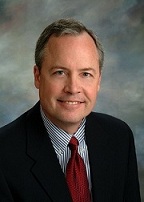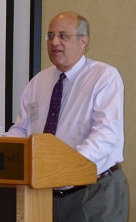| MPF Advisory Council Learns About the Home Loan Banks and the CFPB |
 The new MPF Advisory Council met for the second time this year in Chicago to brainstorm solutions to the challenges affecting mortgage lenders and the MPF Program. Andrew Jetter (right), President and CEO of the Federal Home Loan Bank of Topeka, kicked off the meeting by asking, “How do we as Home Loan Banks and local lenders come together and play a vital role in the future mortgage market?” The new MPF Advisory Council met for the second time this year in Chicago to brainstorm solutions to the challenges affecting mortgage lenders and the MPF Program. Andrew Jetter (right), President and CEO of the Federal Home Loan Bank of Topeka, kicked off the meeting by asking, “How do we as Home Loan Banks and local lenders come together and play a vital role in the future mortgage market?”
The good news, he said, is that Congress has a positive view of both community lenders and the Federal Home Loan Bank System. One hurdle, however, is effectively conveying that the Home Loan Banks (six of which currently offer the MPF Program) are completely different from Fannie Mae and Freddie Mac even though we share the same regulator. One significant and key difference is our ownership structure; the Home Loan Banks are cooperatives.
Plus, during the financial crisis, the 12 Home Loan Banks were part of the solution. “It was the Home Loan Banks that flooded the market with liquidity,” he continued. In 2008, total advances outstanding were $929 billion. “The Home Loan Banks really stepped in and kept the crisis from getting worse.”
And now, even though advances are down to $418 billion in the second quarter of 2012, the Federal Home Loan Bank System is in a position of strength. Retained earnings are at $9.2 billion in the second quarter of 2012, up from $2.9 billion at the end of 2008. “The System has become dramatically stronger in the past few years,” Jetter said.
Mortgage Finance and GSE Reform
Fannie Mae and Freddie Mac continue to dominate the securitization market. Most people understand that a purely private system would not support 30-year mortgages in times of economic stress, Jetter said, and that the U.S. needs an outlet for long-term mortgages. “You’re in a great position,” he told the Advisory Council members. “The MPF Banks are open to ideas.” Plus, the MPF Program is a true partner. “You’re selling to someone that you’re not competing with.”
Given the upcoming federal elections, fiscal cliff deadline, and implementation of many Dodd-Frank regulations, Jetter believes Congress is likely to defer any GSE reform until next year. There is also less urgency to act now that Fannie Mae and Freddie Mac are profitable. However, when the conversation does heat up, he said, “We think it’s critical that we’re part of the dialogue.”
Jetter also believes there is “too much regulation” right now for local lenders, citing the pending QRM (qualified residential mortgage) and Basel III proposals. He said that Congress doesn’t need to get rid of all risk. “The community lenders are not going to bankrupt the country.”
Whatever role the Home Loan Banks play in the future mortgage market, there is general support for the Banks to continue to provide liquidity to community lenders, Jetter said. Above all, “We want to protect members’ investment,” he said. “That shapes what we do in the future.”
 Consumer Financial Protection Bureau Update Consumer Financial Protection Bureau Update
Bart Shapiro (right), a Senior Advisor at the Consumer Financial Protection Bureau (CFPB), also spoke to the 18 individuals representing 18 PFIs that comprise the MPF Advisory Council. The CFPB, which was created by Congress in 2010 as part of the Dodd-Frank Act, regulates large banks and credit unions with $10 billion or more in assets and other non-bank market participants. Shapiro told the group that the
Bureau had been focused initially on building the Consumer Response functions of the Bureau, the centerpiece of the Act. Consumers can now call or visit www.consumerfinance.gov for help making good financial decisions, and a sophisticated routing and tracking system addresses their questions or complaints.
The CFPB has been simultaneously addressing its other stakeholders as well. Shapiro works in the Bureau’s Office of Small Business, Community Banks, and Credit Unions where he hears the voices of organizations and financial institutions that are not directly supervised by the CFPB, but could be impacted by the policies and regulatory requirements of the Bureau. Additionally, he said that the Consumer Advisory Board is “coming soon” and that the Director of the CFPB also wants to form both a Community Banks Advisory Council and a Credit Union Advisory Council.
Regarding both the Consumer Advisory Board and advisory councils, “it’s a chance for people to come together,” Shapiro said. Balancing geography, asset size, and the types of customers served by institutions represented in these councils will help the CFPB pinpoint emerging issues. For example, he said, the councils might identify a software development that banks and credit unions could benefit from because it would keep costs down. Or, the councils could recognize an unfair practice that is popping up in one part of the country and try to address it before it spreads.
The councils will also help inform the CFPB by “sensitizing people to how business is done in certain communities,” Shapiro said. For example, regulators have learned that balloon payments, which some people associate with non-traditional or predatory lending practices, are popular among consumers in rural communities because of farming’s cyclical nature. He noted that Dodd-Frank requires that “we not do things to impede consumers’ access to credit,” he said. Ultimately, the Bureau wants to “make sure the bad [financial] practices are driven out of the marketplace,” Shapiro said.
About the CFPB
The CFPB employs almost 1,000 people, half of whom work in its Washington, D.C. headquarters. The other half works out of regional offices in New York City, Chicago, San Francisco, and the Southeast regional office currently based at headquarters, while some examiners work out of their homes across the country. Shapiro encouraged the PFIs to contact him directly at barton.shapiro@cfpb.gov, with any questions or comments that they may have. |
|